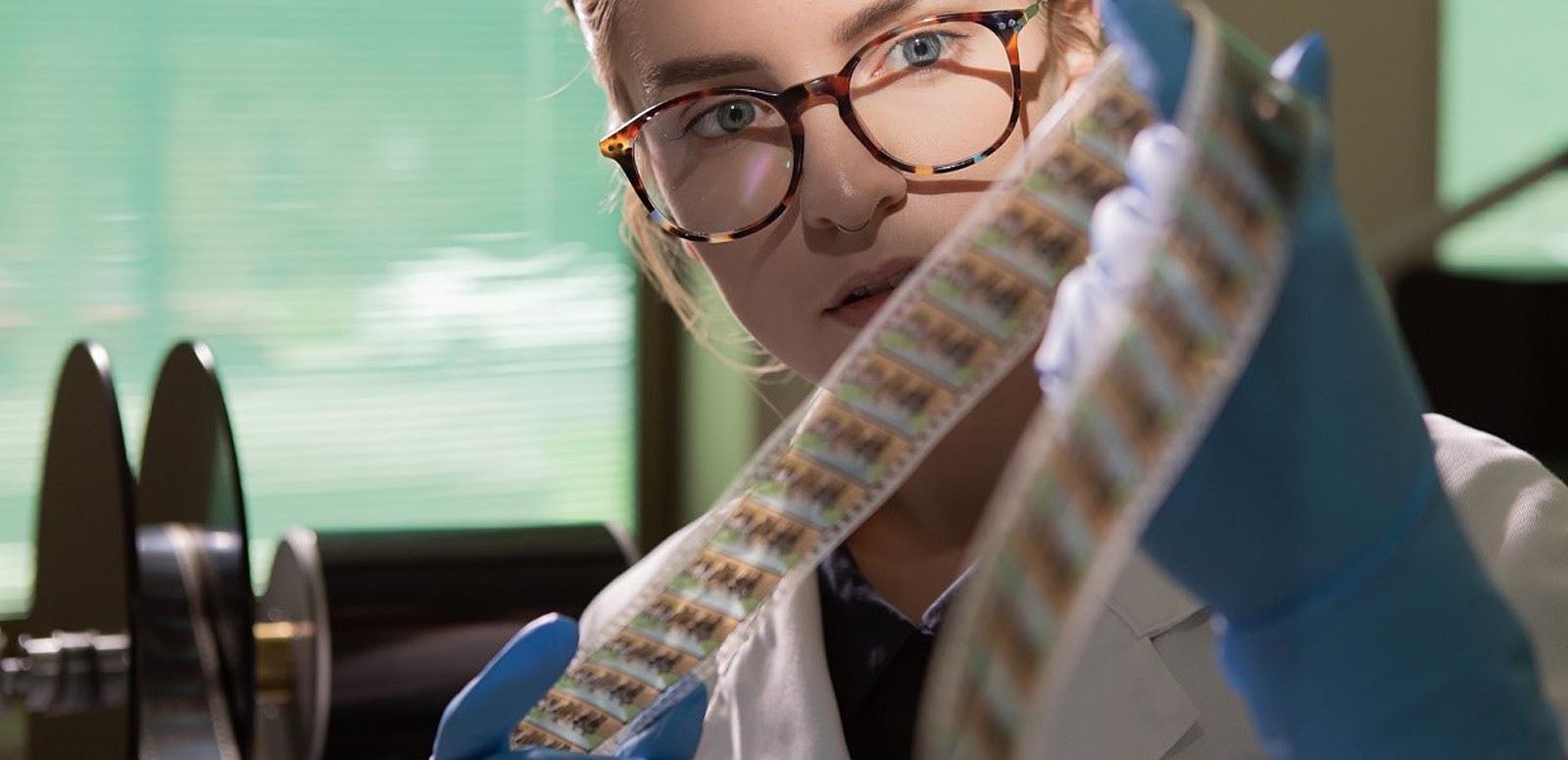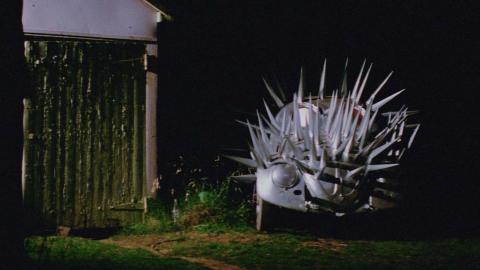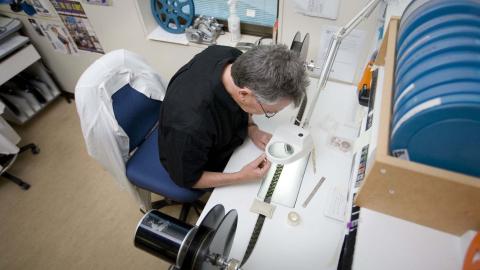

Caring for film
Caring for film
Introduction
Motion picture films are composed of a very thin gelatin emulsion layer coated onto a thin layer of plastic. In older films this plastic base may be the highly flammable cellulose nitrate. Newer film bases, such as cellulose acetate or polyester, are known as `safety’ bases because inhibitors are added to the base during manufacture to prevent the base from burning.
Manufacture of nitrate film ceased in the early 1950s and was mostly 35mm film. Some unusual formats (such as 28mm) which used nitrate as a base may also exist. The most common sizes of `safety’ base films are – 8mm, 16mm and 35mm. The gelatin layer contains either minute particles of silver making up black and white images, or layers of colour dyes making the colour images. All of these materials deteriorate in very different ways, but recommendations for their care are mostly the same. (Film samples shown approximate size)
How long will films last?
The life of films, no matter what the format or type, primarily depends upon the temperature and the humidity at which the film is stored. There has been a great deal said in the past about the impermanence of cellulose nitrate films due to their flammable properties. However, it is becoming increasingly obvious that `safety’ films will also deteriorate rapidly, although they will not burn so readily. The Archive’s collection has nitrate films almost 100 years old which are in good condition and safety films as young as 10 years which are showing signs of deterioration.
What type of films are the best?
Most firms follow strict manufacturing controls, resulting in similar quality for most amateur film. Some filmmakers prefer certain brands because of their particular characteristics, but as long as the film is made by a major company, most operators will obtain a high quality product.
In general, black and white films are more permanent than colour films. Amongst colour materials, reversal films (those where a direct positive image is produced) are more colour stable than negative films or prints made from negatives. In order to get the longest life from the dyes used in colour films, low temperature storage is recommended, making this more expensive and less convenient than the cool conditions required for black and white materials.
How should films be stored?
Storage is the most important consideration for your films at home. They should be in a film container, preferably plastic, and kept in a dry place with minimum temperature and humidity fluctuations. The container will assist with keeping dust and other foreign matter from the film, and prevent unnecessarily rough handling.
Excellent storage for black and white film is a cool dry room (around 15°c-18°c) which maintains stable conditions throughout the year. To ensure your colour materials last for a similar period, temperatures of less than 8°c are recommended – a much more difficult and expensive option. In both cases, the drier and more stable the conditions, the better for the films (although a relative humidity below 15% can cause the emulsion to irreversibly dehydrate and become fragile).
Stored films should be wound onto a spool at moderate tension. The tension that a projector winds film is probably too tight in most instances. The ideal wind tension is when a film just holds itself together on the spool. Before projection the film should be rewound at a greater tension to prevent the film slipping against itself and causing small scratches as the projector pulls the film into the projection gate. If the film has to be transported, such as through the post, then the film should be wound to the same tension as for projection. This will prevent scratching if it is jostled during transport.
Water is a severe hazard to films and may destroy them completely, so films should be kept well away from places where a leak or overflow of water may occur. Remember that water is not always visible, as high humidity environments mean that there is a lot of water in the air which will accelerate the film’s deterioration, and even allow mould to grow. Unfortunately refrigerators are a high humidity environment.
Sometimes the boxes or cupboards used to store the films in may emit chemicals, used in the glue or manufacture of the construction material, which are detrimental to films. Cardboard boxes should be avoided, as should any space which smells strangely. The smells may be from chemicals which have an effect on the stability of your films. Avoid storing films with chemicals, such as cleaning products or paints.
Are your films deteriorating?
If you notice an odd smell coming from films, or one film in particular, then there is a chance that the films have started to deteriorate (all films have a slight `chemical’ smell which is normal). Smells like vinegar or strong mothballs are indicative of deterioration of acetate-type bases. Other problem indicators are small white or clear crystals appearing on the film’s surface, a large degree of curling in on themselves, or the emulsion layer flakes off during handling.
Nitrate base films give off a strong unpleasant odour slightly reminiscent of chlorine bleach. The image will start to fade to a brownish sepia colour and may disappear completely in places. The film will become sticky and eventually turn into a brownish dust. When nitrate film decomposes it becomes more flammable and advice should be sought from an appropriate source such as the Archive or your local fire authority regarding dealing with the film.
If your films start to show any signs of deterioration or mould forming then the best course of action is to separate the particular cans that exhibit the warning signs and seek expert advice.
What precautions should you take with projectors?
Always clean the gate of your projector with a small brush before projecting your film. This should get rid of any hairs or dust which spoil the projected image and cause damage to your film as it passes through the gate.
When handling film always hold it by the edges with your fingertips to avoid touching the emulsion (the dull side of the film) as this is the most easily damaged part and where the image rests.
If at any stage during a screening you notice the projector behaving strangely or making an unusual sound, there is a chance you are causing damage to the film. Stop the projector immediately and check to ensure the film is properly threaded. Regular servicing of projectors will minimise the chances of such mishaps.
Because of their flammable nature nitrate films require special precautions and may even require a permit to be issued before the film can be projected. Check with your local authorities regarding legislation surrounding the use and handling of dangerous goods.
Will films last longer if they are not used?
Yes. There is a direct correlation between the amount of time a film is handled and how long it lasts. Every time you project a film there is an increased risk that the film will suffer physical damage from the projector. If you wish your film to last for its maximum life, it would ideally not be used at all. However, this defeats the purpose of having the material. One approach which is used in archives throughout the world is to have copies of the film made (video is very convenient) and to play these copies rather than the originals. In this manner the film can be both seen and kept in storage.
How can I protect my films from natural disaster?
You should consider safeguarding any images of great personal importance from extreme hazard, such as household fires, by copying them and storing the copies elsewhere. Films can be transferred to video and videos to other videos. Negatives of photographs can be stored away from the prints. If the prints are destroyed, new copies can be made from the negatives, if the negatives are destroyed new negatives can be made from the prints, though these will be of lesser quality than the originals.
Please note – The advice given here in regard to the care of film is based on best international experience and the best information available to the NFSA. However, given the different circumstances applying to the condition of any particular film we cannnot be responsible for the application of this advice in any particular circumstances. To be sure of the best care of your films you may wish to seek specialist advice.
The National Film and Sound Archive of Australia acknowledges Australia’s Aboriginal and Torres Strait Islander peoples as the Traditional Custodians of the land on which we work and live and gives respect to their Elders both past and present.


